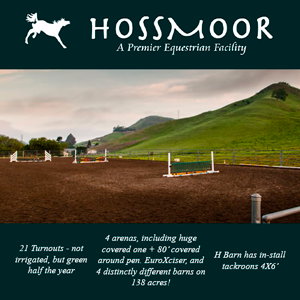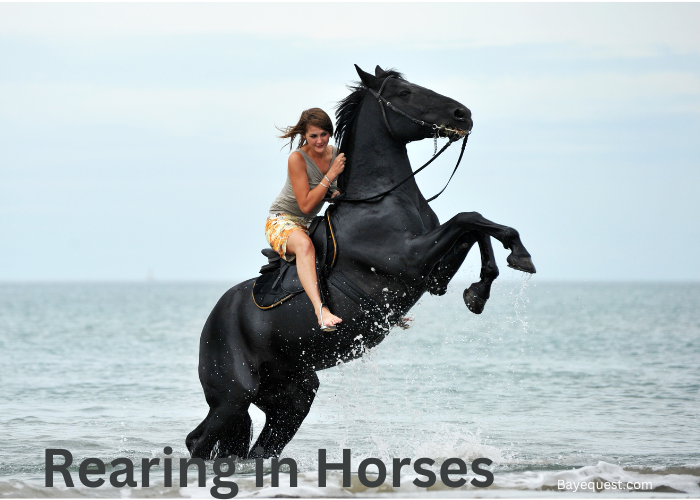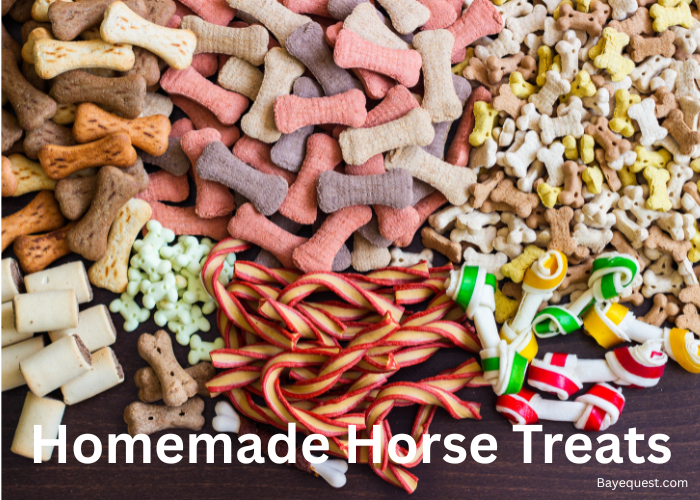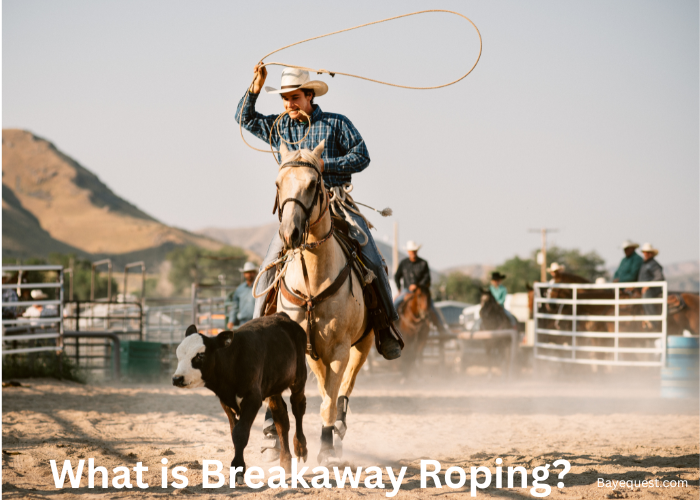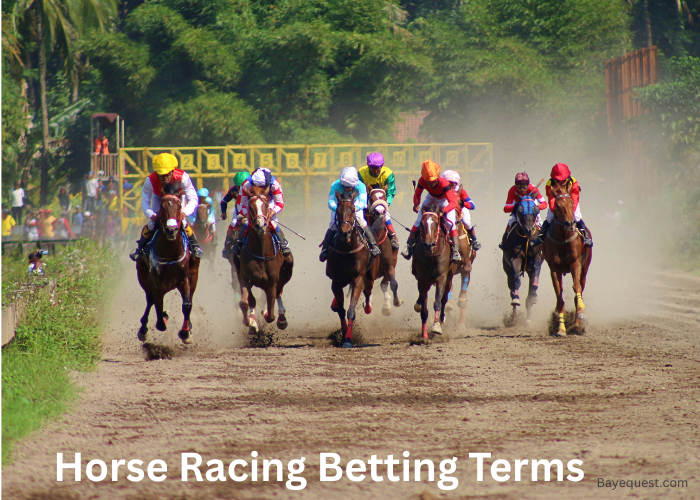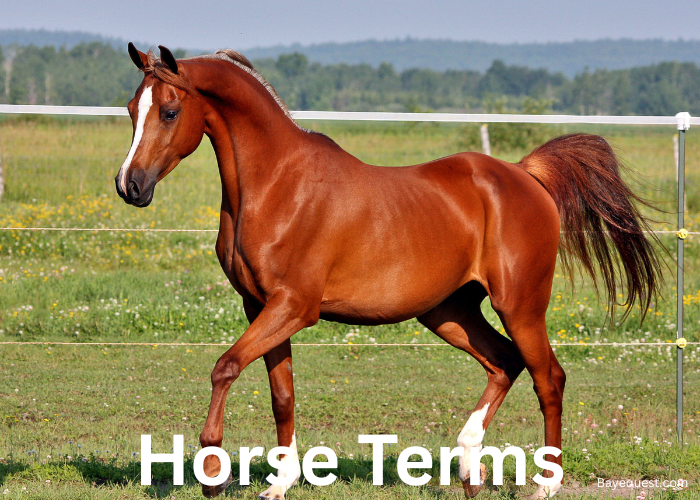A rearing horse is a heart-stopping sight. One moment, all four hooves are on the ground. The next, the front legs shoot into the air.
It’s a dangerous move. One that can unseat a rider or even flip a horse over.
Some horses rear out of fear. Others do it to test their rider.
Either way, it’s a problem that needs fixing fast. The good news? Rearing isn’t random. There’s always a reason behind it.
Understanding why it happens is the first step to stopping it. Let’s break it down and keep those hooves where they belong. On solid ground.
Horse Rearing: Key Takeaway
Rearing in horses happens when a horse lifts its front legs off the ground. It can be caused by pain, fear, confusion, or poor training. Rearing is dangerous and can lead to falls or injuries. Prevent it with proper training, clear communication, and ensuring the horse is free from pain or discomfort.
What is Rearing in Horses?
Rearing in horses happens when a horse lifts its front legs off the ground, balancing on its hind legs.
It can be a quick, minor lift or a full blown rear where the horse stands nearly vertical. While it may look dramatic, rearing is a serious and dangerous behavior.
Horses rear for different reasons. Some do it out of fear, while others use it as an act of defiance.
Pain, poor training, or confusion can also trigger it.
Regardless of the cause, rearing is risky as it can unseat a rider, cause the horse to lose balance, or even result in serious injuries.
Common Causes of Horse Rearing
Horses don’t rear without a reason. Let’s break down the most common reasons horses rear.
Pain and discomfort
A horse in pain has few ways to communicate, and rearing can be a desperate reaction.
Ill-fitting tack, a sore back, or an uncomfortable bit can cause sharp pain, making the horse resist movement.
If stepping forward means more discomfort, a horse may rear instead of complying. Hidden injuries or joint pain can also play a role.
Before blaming behavior, always rule out physical pain with a thorough check-up and proper tack fitting.
Fear and anxiety
Fear is one of the most common reasons a horse rears. A spooked horse may instinctively lift off the ground to escape what it perceives as danger.
New environments, sudden noises, or unexpected objects can trigger this response.
Horses with nervous temperaments are especially prone to rearing when they feel trapped. If they think their only way out is up, they’ll take it.
Building trust and confidence through consistent handling can reduce fear-based reactions.
Rider’s actions
A rider’s hands, seat, and legs send signals, but if those signals are unclear or harsh, a horse may react by rearing.
Pulling too hard on the reins, especially while restricting forward movement, can make a horse feel trapped.
Overusing pressure without release can also cause frustration. Inexperienced riders sometimes send mixed messages, confusing the horse into resisting.
A balanced, steady rider who understands proper cues can help prevent these issues.
Health issues (Dental or vision problems)
Undiagnosed health issues can lead to sudden, unpredictable rearing. Dental problems, like sharp points or abscesses, can make wearing a bit painful.
A horse with mouth pain may rear in protest when asked to work. Vision issues can also cause unexpected rearing.
If a horse struggles to see clearly, it may panic when faced with unfamiliar objects, especially if it feels cornered.
Regular dental care and veterinary checkups are essential to catch these problems early.
Training and behavior issues
Some horses rear because they weren’t taught proper manners. If a young horse learns that rearing helps it avoid work, it may develop the habit.
Poor groundwork, skipped training steps, or inconsistent discipline can all lead to behavioral rearing.
A horse that isn’t taught to move forward willingly may resort to going up instead.
Clear expectations, patient training, and reinforcing correct responses can prevent rearing from becoming a habit.
Confusion
A confused horse is a frustrated horse.
If a rider gives conflicting aids, like pulling back on the reins while also asking for forward movement, the horse may freeze up and rear.
Similarly, if the horse doesn’t understand what’s being asked, it might panic and lift off the ground.
Rushed training or unclear commands are common culprits.
Ensuring a horse fully understands cues through slow, progressive training can reduce confusion based rearing.
Poor training
Some horses rear because they weren’t properly trained from the start.
Rushed or inconsistent training creates gaps in understanding, leading to behavioral issues.
If a horse is punished harshly without learning the right response, it may become defensive.
On the other hand, a horse that has been spoiled and allowed to misbehave might rear as a way to resist work.
Proper groundwork, patience, and reinforcing good behavior are crucial for preventing rearing due to poor training.
Under or overstimulation
A horse that doesn’t get enough mental or physical activity may develop unwanted behaviors, including rearing.
Boredom can lead to pent-up energy, making a horse more reactive.
On the flip side, an overstimulated horse, one that’s overwhelmed by too much noise, movement, or pressure, may rear as a way to release tension.
Finding a balance in exercise, training, and relaxation time helps prevent overstimulation and boredom-related rearing.
Lack of respect and boundaries
Some horses rear because they’ve learned they can get away with it.
If a horse isn’t taught to respect the rider’s authority, it may use rearing as a way to resist commands.
A horse with no clear boundaries might rear to avoid moving forward, stopping work, or even intimidating the rider.
Consistent groundwork, firm yet fair discipline, and clear expectations help establish respect and prevent dominance-related rearing.
Why is Rearing in Horses Dangerous?
Rearing in horses is dangerous because of the following reasons:
Risk of the horse falling over backward
The most serious danger of rearing is the risk of the horse flipping over. If a horse loses balance while rearing, it can fall backward onto the rider, causing devastating injuries.
This can result in broken bones, spinal injuries, or even death for both the horse and rider.
Horses that rear too high or have poor balance are at an even greater risk of toppling over.
Increased chance of rider being unseated
When a horse rears unexpectedly, the rider can easily lose balance and fall.
Unlike a typical fall from a moving horse, being thrown backward from a rearing horse often means landing hard on the back, head, or shoulders.
This increases the risk of serious injuries such as concussions, broken ribs, or spinal damage.
Even if the rider stays in the saddle, the sudden movement can cause whiplash or muscle strain.
Loss of control
A rearing horse is difficult to control and, in some cases, impossible to manage. When a horse is on its hind legs, it is not responsive to rein or leg aids.
This makes steering, stopping, or guiding the horse extremely difficult, especially in high-stress situations such as riding on the road, in competition, or on difficult terrain.
A rearing horse can quickly escalate into a runaway horse if the rider cannot regain control.
Danger to people and other horses nearby
Rearing doesn’t just put the rider in danger. It also poses a threat to people and horses nearby.
A horse that rears in a crowded space, such as a stable, showground, or group ride, can accidentally strike someone with its front legs or knock over another horse.
In extreme cases, rearing can lead to fights between horses if one feels threatened.
Possible injury to the horse itself
A horse that frequently rears is also putting itself at risk.
Landing awkwardly from the rear can cause serious leg injuries, including tendon strains, fractures, or joint damage.
If a horse flips over, it may suffer head trauma, spinal injuries, or internal damage.
Even if the horse doesn’t fall, repeated rearing can strain its muscles and joints, leading to long-term physical issues.
Development of a dangerous habit
If rearing is not addressed early, it can become a learned behavior.
Some horses discover that rearing gets them out of work or allows them to avoid a situation they don’t like.
Once this behavior is reinforced, it becomes harder to correct.
A horse that consistently rears is not only dangerous to ride but also difficult to handle on the ground, making everyday care and training more challenging.
What to Do When Horse Rearing Becomes a Problem
Rearing is frustrating and dangerous. Here’s what to do when rearing becomes a problem.
Stay calm and in control
The worst thing you can do when a horse rears is panic. Stay balanced in the saddle, lean slightly forward, and avoid pulling back on the reins.
Pulling too hard can make the horse feel trapped, increasing the risk of flipping over.
Encourage forward movement
Rearing often happens when a horse feels stuck or refuses to move forward. Use gentle leg pressure to encourage movement.
If the horse resists, try circling instead of forcing straight ahead. Keeping the feet moving helps prevent rearing.
Check for pain or discomfort
Before assuming it’s a behavior problem, rule out pain. Check your tack for fit issues. An ill-fitting saddle, a pinching bit, or a sore back can all trigger rearing.
Have a vet examine your horse for injuries, dental problems, or vision issues.
Improve groundwork
A horse that respects its handler on the ground is less likely to rear under saddle. Work on lunging, yielding the hindquarters, and responding to cues.
A horse that moves forward willingly on the ground will be more likely to do the same under saddle.
Avoid harsh punishment
Hitting or yanking on the reins when a horse rears can make the problem worse.
Instead of punishing the reaction, address the cause and use consistent, positive reinforcement to correct the behavior.
Work with a professional trainer
If your horse’s rearing is persistent or dangerous, seek help from an experienced trainer.
A skilled professional can assess the horse’s behavior, identify the root cause, and create a training plan to correct the issue safely.
Know when to step off
In extreme cases, staying on a rearing horse can be risky.
If you feel like the horse might go over backward, it’s safer to step off and regain control from the ground. Your safety always comes first.
Be patient and consistent
Rearing won’t disappear overnight. It takes time, patience, and consistent training to fix.
Stay calm, use clear cues, and reward good behavior. The goal is to build trust and confidence so the horse no longer sees rearing as an option.
How to Prevent Rearing
Here’s how to prevent rearing in horses effectively.
Ensure the horse is free from pain
To prevent pain, always check that your horse’s tack fits correctly. An ill-fitting saddle, a pinching bit, or a tight noseband can cause discomfort that leads to resistance.
Additionally, schedule regular vet checkups to rule out underlying health issues, including back pain, joint stiffness, or dental problems.
If a horse is uncomfortable, it will find ways to express that discomfort, sometimes by rearing.
Establish clear communication through training
Confusion often leads to rearing. Horses rely on clear and consistent cues from their riders.
If a horse doesn’t understand what’s being asked, it may become frustrated and react by rearing.
To prevent this, ensure that your riding and training signals are clear and easy to follow.
Avoid sending mixed messages, such as pulling on the reins while also asking for forward movement.
If a horse consistently struggles with certain commands, go back to groundwork to reinforce proper responses.
Encourage forward movement
A horse that willingly moves forward is far less likely to rear. Rearing often occurs when a horse feels restricted or doesn’t want to go forward.
Encourage forward momentum by using steady leg pressure and keeping the horse engaged in movement.
If a horse hesitates, avoid pulling back on the reins, as this can make it feel trapped.
Instead, use gentle cues to ask for forward motion, and if needed, redirect the horse in a small circle to keep it moving.
Build confidence and reduce fear
Fear-based rearing happens when a horse feels threatened or overwhelmed.
To prevent this, work on building your horse’s confidence through desensitization training.
Gradually expose the horse to different environments, obstacles, and sounds to help it become more comfortable in new situations.
If a horse consistently reacts fearfully to certain stimuli, take the time to introduce those elements in a controlled and reassuring manner.
Use proper groundwork techniques
Good behavior starts on the ground. Horses that respect their handler on the ground are less likely to develop dangerous habits under saddle.
Regular groundwork exercises, such as lunging, yielding the hindquarters, and responding to pressure, reinforce discipline and respect.
Teaching a horse to move forward willingly and listen to cues from the ground helps prevent resistance and rearing when riding.
See also: How to Fit a Saddle to a Horse.
Avoid harsh corrections and overreactions
Overly harsh corrections can create anxiety and tension, leading to rearing.
If a horse feels threatened or unfairly punished, it may react defensively by rearing.
Instead of using forceful methods, focus on reinforcing positive behavior with consistent, calm training.
Horses respond best to fair and balanced leadership.
If a horse struggles with a particular command, break the task into smaller steps rather than resorting to excessive correction.
Manage energy levels properly
A horse that is overly energetic or underworked may be more prone to misbehaving, including rearing.
Ensuring that your horse gets adequate turnout, exercise, and mental stimulation is essential for good behavior.
A horse that is pent up and full of energy may resort to undesirable behaviors as an outlet.
Regular exercise, engaging training sessions, and various routines can help prevent excess energy from turning into rearing or other bad habits.
Establish boundaries and respect
A horse that lacks boundaries or has learned that rearing gets it out of work may continue the behavior.
Prevention starts with consistent leadership and clear expectations.
If a horse learns early on that rearing doesn’t work as an escape or form of resistance, it is less likely to develop the habit.
Reinforce respectful behavior with consistent training, ensuring that the horse understands its job and follows commands without resistance.
Work with a knowledgeable trainer if needed
If you’re dealing with a horse that has shown signs of rearing or has a tendency to resist work, working with an experienced trainer can be a smart investment.
A professional can assess the situation, pinpoint any weak areas in training, and provide specific exercises to help prevent rearing.
Addressing potential issues early on can prevent a small problem from becoming a dangerous habit.
Rearing in Horses. Conclusion
Rearing is dangerous for both horse and rider. It can lead to serious injuries, loss of control, and bad habits.
The key to stopping it is understanding the cause. Pain, fear, confusion, or poor training can all play a role. Prevention is always easier than correction.
Clear communication, proper groundwork, and building trust help keep a horse’s hooves on the ground.
If rearing becomes a problem, stay calm and seek professional help if needed. Safety comes first.
With patience and the right approach, you can train a horse to move forward instead of going up.



